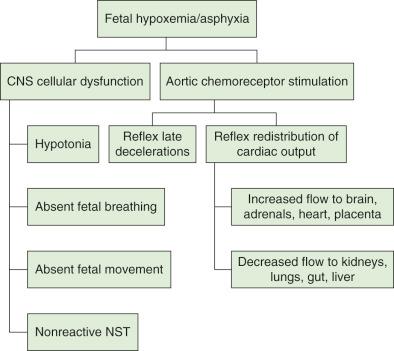Physical Address
304 North Cardinal St.
Dorchester Center, MA 02124
The biophysical profile (BPP) was first described in 1980 as a method to quantify and standardize antepartum fetal evaluation. The full BPP test is performed using a combination of real-time ultrasound (US) and cardiotocography, also known as a nonstress test (NST). The US component combines the assessment of four activities: fetal movement, fetal breathing, and tone over a 30-minute period, along with amniotic fluid assessment. The NST component continuously monitors the fetal heart rate and uterine activity over 20+ minutes. Relative indications for antepartum fetal surveillance, including BPP, are listed in Table 125.1 . The BPP is usually initiated only after 32 weeks for patients at risk of stillbirth. In patients with multiple or severe comorbidities, BPP testing may begin at even earlier gestational ages if delivery would be considered for fetal benefit.
| Maternal Conditions | Pregnancy-Related Conditions |
|---|---|
|
|
* These indications are considered relative, because antepartum fetal surveillance results have not been definitively demonstrated to improve perinatal outcome.
Five variables—breathing, movement, tone, amniotic fluid volume, and NST—are included in the test. Table 125.2 describes the specific parameters required to obtain a score of 2 in each category. A reassuring BPP score is 8 or 10 out of 10, whereas a score of 6 is equivocal, and 4 or less is abnormal. These parameters are indicators of a functional fetal central nervous system and absence of hypoxemia ( Fig. 125.1 ).
| Parameter | Description | Score |
|---|---|---|
| Breathing | ≥1 episode of ≥30 seconds in 30 minutes. Hiccups are considered breathing activity. | 2 |
| Movement | At least three body or limb movements in 30 minutes. | 2 |
| Tone | At least one episode of active extension/flexion in 30 minutes. | 2 |
| Amniotic fluid | A single 2 cm × 2 cm pocket. | 2 |
| Nonstress test | Two accelerations >15 beats per minute of at least 15 seconds duration. | 2 |

The composite score is better at differentiating normal from compromised fetuses than any single parameter. In a study evaluating patients undergoing elective prelabor cesarean delivery, predelivery BPP yielded 90% sensitivity, 96% specificity, and 82% positive and 98% negative predictive value in predicting fetal acidosis, defined by an umbilical cord arterial pH <7.20. The efficacy of composite BPP to indicate fetal acidosis was found to be superior to the 1- and 5-minute Apgar scores in sensitivity and positive predictive value. A modified BPP, using only NST and amniotic fluid assessment, has also been found to have good predictive value, and is commonly used.
A normal BPP is considered highly reassuring, as reflected in the low false-negative rate of antepartum fetal surveillance, defined as the incidence of stillbirth occurring within 1 week of a normal test result. The negative predictive value is 99.8% for the NST and is greater than 99.9% for the contraction stress test, BPP, and modified BPP.
Decreased fetal breathing.
Decreased fetal breathing is defined by the absence of at least one 30-second segment of continuous fetal breathing over a 30-minute real-time examination. Some experts accept fetal hiccups as equivalent to breathing, although no data are available on the reliability of this sign.
Fetal breathing occurs intermittently and usually develops around 20 weeks' gestation, fluctuating throughout the day. In a study continuously evaluating fetal breathing behavior in 11 healthy women at 34–35 weeks of gestation, breathing frequency changes were seen with meals (increase 2–3 hours following consumption) and during the night (between 1 and 7 a.m.). Fetal gross movements and breathing movements are present for periods of 20–60 minutes out of every 1–1.5 hours of observation time, likely reflecting biologic changes of sleep state in the fetus.
Factors implicated in altered fetal breathing are noted in Table 125.3 . When a fetus is acidotic, the first fetal behavior changes are a nonreactive NST and loss of fetal breathing motion. In animal models, fetal breathing movements cease abruptly when the tissue PO 2 falls by about 8 to 10 torr.
| Increased Breathing | Decreased Breathing | No Change |
|---|---|---|
|
|
|
Absence of rhythmic movement of the chest, diaphragm, and abdominal wall, occurring at a frequency of 1/sec ( ).
US real-time imaging is used to visualize fetal chest and abdominal walls, and diaphragmatic motion. The image can be obtained in the coronal, sagittal, or less ideally, transverse plane. M-mode can also be used to document wall motion. A clip or video of the fetal breathing motion should be recorded when technology permits (see ). It is important to ensure that the movement noted is not from maternal breathing motions or fetal cardiac activity moving the diaphragm.
Fetal sleep cycle or other external factors decreasing movement. (See Table 125.3 )
Decision on expectant management, repeat surveillance or delivery should be based made on the composite BPP score, factoring in gestational age and other relevant clinical parameters.
Become a Clinical Tree membership for Full access and enjoy Unlimited articles
If you are a member. Log in here